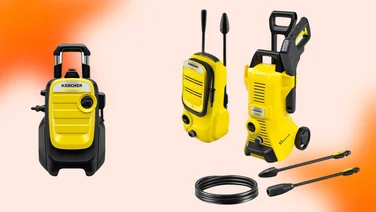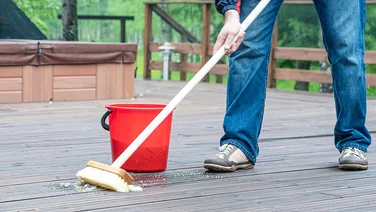To help us provide you with free impartial advice, we may earn a commission if you buy through links on our site. Learn more

On a sunny, suburban afternoon, someone giving their car a thorough go over with a powerful cleaning tool like a pressure washer is a common sight. But is it safe to wash a car with a pressure washer? While they may be more than up to the task of clearing grime from around the wheels and lifting dirt and dust from your car’s bodywork, the powerful water jet of a pressure washer can also potentially cause damage to your vehicle.
The answer to the question in the title of this article then, ultimately, will depend on the techniques you use, the level of care you take and the tools you’re working with, all of which we’ll discuss in more detail below. To learn more about the mistakes to avoid and the steps to take to get a safe clean, we also spoke to Paul Hicks, product and marketing manager at STIHL GB, to get his expert advice.
Is it safe to wash a car with a pressure washer?
Before we get onto cleaning tips, let’s answer this question in a little more detail. If you read our ’things you shouldn’t clean with a pressure washer’ guide, you’ll see that cars do feature as a segment on that list. In that article we highlight the risks of cleaning your car with the pressure washer’s nozzle too close to the vehicle and using too high a pressure, warning that if you get too close “you can risk stripping paint from your car, which could eventually lead to rusting and expensive bodywork repairs. Additionally, high pressure can damage delicate trim, seals and even your electronics if water is forced into sensitive areas.”
As Paul Hicks notes though: “pressure washers can safely be used to quickly and effectively clean your car: but care must be taken, or you could end up damaging your vehicle.” So, without further ado, let’s take a look at the things we need to do to take the pressure off and ensure a risk-free clean.
How to safely wash your car with a pressure washer
Follow the step-by-step instructions below to get your motor sparkling clean, without any worry of damaging your car.
1. Ensure your own safety first
- Invest in safety goggles, thick rubber gloves and non-slip shoes
Before you start cleaning, make sure you’ve taken all the necessary safety precautions. Paul gives the following safety checklist: “You should always wear close-fitting safety glasses to protect your eyes from any dirt or debris that may be thrown up. It’s also important to make sure your shoes have non-slip soles as many surfaces can become slippery when wet – especially if you’re using a detergent with your pressure washer.” Thick rubber gloves are also recommended, to protect your hands from the pressure washer’s jet and any chemical detergents you might use.
2. Clean at the right outdoor temperature
- Be aware of sudden changes that could damage paintwork
This is a factor that you might not think of straight away, which is why it is helpful to have expert advice at hand. Paul from STIHL reminds us that while cleaning your car and getting a simultaneous suntan might sound like a stellar prospect, it might not be the best idea: “Before cleaning, take note of the temperature outside, as dramatic changes in temperature can cause damage to the paintwork. If it’s a hot summers day for example, wash your car
in the morning or evening to avoid sudden changes.”
3. Clear loose dirt and debris
- Remove small debris by hand
- Rinse off coarse dirt

Paul suggests that you “start by removing any leaves, twigs etc. by hand,” to reduce the risk of any piece of debris coming loose at a high velocity. Next, move onto tackling the visible dirt on your car’s bodywork, as Paul suggests: “to protect your car’s paintwork, start by rinsing off coarse dirt at a low pressure using a fan jet nozzle, making sure you only apply the jet at a shallow angle to the exterior paint.” If you’re unsure about which nozzle to use, the attachment you’re looking for should be a 40-degree nozzle.
4. Tackle stubborn dirt on the body
- Keep a good distance from your car
- Never exceed 200 bar
- Use a 40-degree nozzle
Next, it’s time for the bulk of the cleaning. With your 40-degree nozzle still attached and making sure you’re “at least 30cm away from the car to protect the paint, ” as Paul suggests, get to work on hosing down your car. If you can’t shift the dirt, Paul adds that “if you need to, you can gradually increase the pressure to remove stubborn dirt, but very high pressures can easily cause damage; I recommend never going over 200 bar when pressure washing a car.” We should note that for most standard cleaning jobs, you usually shouldn’t have to go any higher than 130 bar pressure.
5. Clean the tyres and other delicate parts
- Maintain a safe distance
- Use a 25-degree nozzle

Carefully done, a pressure washer can tidy up your tires much more quickly than a sponge and bucket set-up. We recommend taking on this job with a 25-degree nozzle to avoid damaging your tires and maintaining the safe distance as recommended for your paintwork. Paul agrees, adding that “you can clean rims and tires with your pressure washer, but don’t point your jet directly at the rubber elements while you’re working.”
6. Get some extra cleaning power from a detergent
- We recommend Autoglym Bodywork Car Shampoo
To reduce your reliance on increased power and pressure, you can pair your pressure washer with a car shampoo to help lift dirt and grime more easily. To do this, you’ll need a suitable car shampoo and a pressure washer with a detergent reservoir. Whatever brand you’re using, just make sure to follow both the manufacturer’s instructions for your pressure washer and the directions provided on the car shampoo or detergent itself, to ensure that you get a thorough clean and avoid causing any damage to your car’s paintwork.






